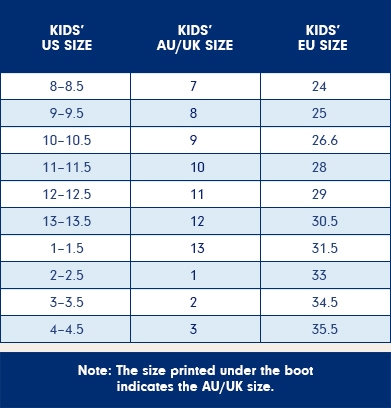Understanding European Shoe Sizes For Your Little Aussie: A Parent’s Guide
Hello, super parents! Are you feeling a bit like you’re solving a puzzle when it comes to buying shoes for your children? You’re not alone! ? With so many brands and styles to choose from, and the added complexity of different sizing standards from across the globe, shoe shopping can quickly become more confusing than it needs to be. In this ultimate guide, we’re going to simplify the process of converting European shoe sizes to Australian for your kids, so you can say goodbye to the guesswork and hello to perfectly fitting shoes every time!
Why Understanding Shoe Size Conversion Is Important?
Let’s start with the basics. Purchasing the incorrect shoe size not only wastes time and money but can also affect your child’s foot development and walking pattern. That’s why knowing how to accurately convert European sizes to Australian is a must for any parent. And guess what? It’s easier than teaching kiddos to tie their laces (we promise!).
Decoding the Numbers: EU vs AU Shoe Sizing
In Europe, shoe sizes are generally measured in centimeters, but they follow a numerical sizing standard that can seem a bit abstract compared to the Australian system which is based on UK sizes and often uses a mix of age and length measurements. When it comes to kids’ shoes, understanding the corresponding Australian size can help you source the best fit from international brands that may catch your little one’s eye.
Step-by-Step Guide to Shoe Size Conversion
Fret not, for we have created an easy-to-follow conversion process to make international shoe shopping as enjoyable as an afternoon playing at the park. Here’s what you can expect to learn:
- An in-depth look at European children’s shoe sizing
- How to measure your child’s feet accurately at home
- A detailed European shoe size to Australian conversion chart
- Tips and tricks on ensuring the best shoe fit for your child
By the end of this guide, you’ll be the go-to shoe size guru in your parenting circle, impressing everyone with your savvy sizing skills!
Measuring Your Child’s Feet: The Foundation of a Perfect Fit
To start the transition from European to Australian shoe size on the right foot (pun intended!), it’s essential to get an accurate measurement of your child’s feet. Here are some pro tips to get you started:
- Grab a sheet of paper, a pen, and a ruler or measuring tape.
- Let your child stand on the paper and mark the tip of the longest toe and the back of the heel.
- Measure the distance between these two points in centimeters (which will correlate with European shoe sizes).
- Check your measurements against a reliable size chart.
Remember that children’s feet grow at lightning speed, so it’s best to check their size every few months—especially before purchasing new shoes.
Armed with these tips, your next shoe-shopping adventure should be a breeze. Just think of how thrilled your little ones will be with their comfy new kicks—for beach days, playground fun, or those special family outings that create memories for a lifetime. And when you find that perfect European brand that makes your child’s eyes light up, you’ll be fully equipped to snag the right size, as easily as 1-2-3!
But there’s more to this sole-searching journey! Hang tight, because we’re about to dive into the actual conversion charts that will make shoe shopping smooth sailing. Get ready to transform centimeters into Australian sizes and discover the perfect fit for your child’s happy little feet!

Five Essential Tips for Parents Preparing for European to Australian Shoe Size Conversion
Becoming a whiz at converting shoe sizes means equipping yourself with a few golden nuggets of wisdom. Here are five key points that will steer you on the path to conquest in the realm of children’s footwear!
-
Understand the Sizing Increments:
European children’s shoe sizes increase roughly in 6.6 mm increments, which is quite precise, compared to Australian sizes that increase in 8.46 mm increments. Recognizing this distinction will help you find the most snug and comfortable fit for those growing feet.
-
Don’t Rely Solely on Age References:
While some shoe size systems include age as a reference, children’s feet grow unpredictably. What’s perfect for one 5-year-old might not suit another. Always prioritize the measurement of the foot over age when selecting sizes.
-
Consider the Width of Your Child’s Feet:
A shoe’s fit isn’t just about length. The width can play a critical role in comfort, especially when converting sizes between different standards. Some European brands are known for offering varied widths, so keep an eye out for this feature.
-
Allow Room for Growth:
It’s always wise to leave a little extra room when selecting shoes for kids. A thumb’s width (about 1.5 cm) between the end of the longest toe and the tip of the shoe is recommended, to accommodate those sudden growth spurts.
-
Keep Seasonal Changes in Mind:
Remember that children’s feet often swell in hot weather and require more room. Conversely, thick winter socks may necessitate larger or wider shoes. Consider these factors when shopping for shoes out of season.
Equipped with these tips, let’s move on to the nitty-gritty: the size charts and conversion tools that will demystify the process…
Conversion Charts: Your Best Friend in Shoe Shopping
Conversion charts are a saving grace for international shoe shopping. They make it possible to compare sizes at a glance, helping you make informed decisions without second-guessing. Here’s how to use them:
- First, make sure that the chart you’re using is up-to-date and from a reliable source.
- Locate your child’s EU shoe size on the left side of the chart.
- Look directly across from the EU size to find the corresponding AU size.
- If your child’s measurement falls between sizes, choose the larger size for comfort and growth room.
It’s also important to note that different brands might vary slightly, so when possible, refer to the specific brand’s size guide or customer reviews for insights on how their sizes run.
Practical Tips for Ensuring the Best Shoe Fit for Your Child
Finding the ideal shoe is about more than length and width; it’s about how the shoe is constructed and how it conforms to your child’s foot. Here are some practical tips to bear in mind:
- Always have your child try on shoes with the same type of socks they’ll be wearing with them.
- Consider shoes with adjustable closures, such as velcro or laces, to accommodate variable foot widths.
- Check for any uncomfortable seams, stiff areas, or restrictive toe boxes. Comfort is key!
- Look for flexible soles that bend with the foot, offering a natural walking experience.
- Monitor for signs of discomfort: If the shoes are leaving marks on your child’s feet, they’re probably too small or narrow.
Knowing these practical aspects, you can confidently steer through the vast ocean of options, guiding your precious young explorers to shoes that keep their steps safe and supported.
As much as we love to equip you with all this knowledge, there’s something else that’s also important: experience. Each time you shop for new shoes, you’ll learn a bit more about your child’s needs and preferences. Combine this experience with our comprehensive guide, and you’ll become a veteran in converting European shoe sizes to Australian in no time at all!
Remember, a shoe that fits well is a shoe that feels invisible. Your kids should be free to play, skip, and hop without a second thought about their feet—except maybe to admire how cool their new shoes look!
So there you have it, parents! Keep this guide handy, and next time you’re wading through the world of children’s footwear, you’ll do so with confidence and finesse. Happy shoe shopping!
For more great articles please see here. For more information see here
Disclaimer
The articles available via our website provide general information only and we strongly urge readers to exercise caution and conduct their own thorough research and fact-checking. The information presented should not be taken as absolute truth, and, to the maximum extent permitted by law, we will not be held liable for any inaccuracies or errors in the content. It is essential for individuals to independently verify and validate the information before making any decisions or taking any actions based on the articles.




